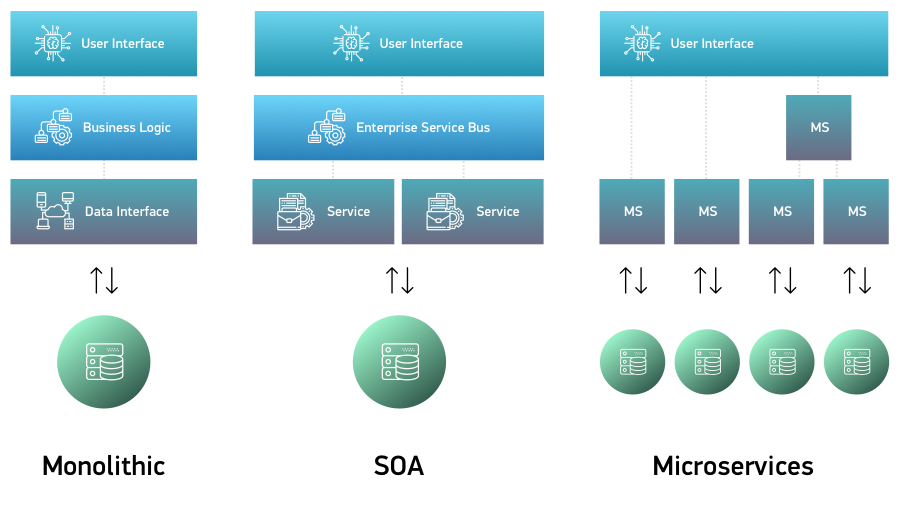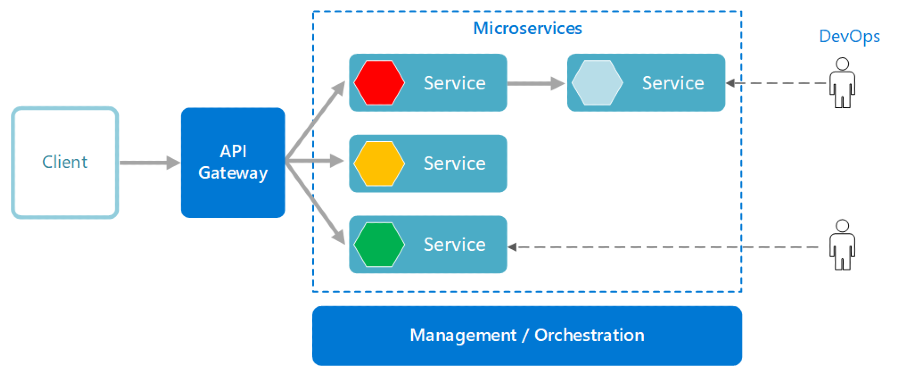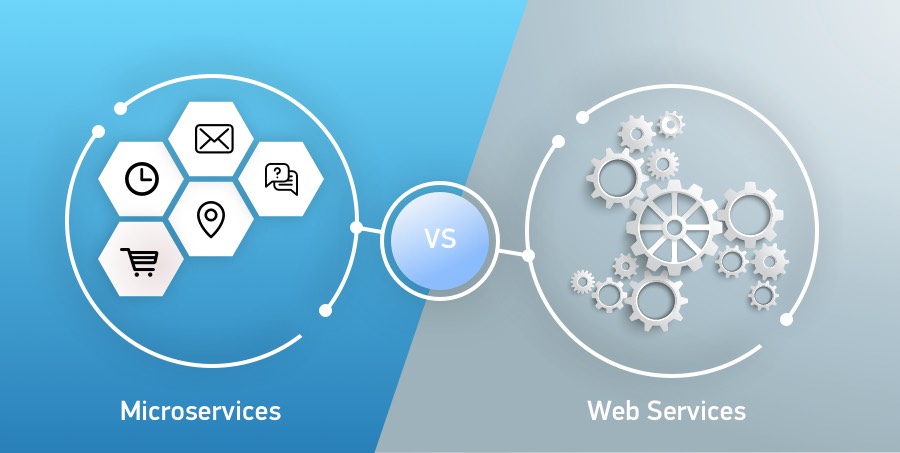Before the era of web services and microservices, software engineers have always been on the pursuit to build perfect information systems and automated solutions. Trailing on old technologies has inspired new ones by adapting and improving on existing systems.
On the other hand, the adoption of new technologies by IT companies is leading to a new height of business solutions and client satisfaction. The desire for better systems combined with the command of how the web functions gave birth to microservices and web services.
Importance of Microservices and Web Services
Microservices and web services have been instrumental in providing high-grade software. They are a good alternative to software solutions based on the monolithic architecture that made them so popular.

Microservices architecture, however, doesn’t fit for every solution. Some solutions keep calling for web services rather than microservices and vice versa.
In comparison, both microservices and web services have wide functionality. They use separate domains in contrast to the monolithic codes that use separate data storage, data model, and so on. In this article, we will be analyzing the concept of microservices and web services as well as their strengths.
What are Microservices?
Microservices are a software architecture that can be used alongside web services. This method involves the splitting of large software applications into decoupled modules where microservices run unique processes and communicate through APIs. Its development can be through the use of either messaging, event-driven APIs, or using non-HTTP backed RPC mechanisms.
Besides for the modules themselves, a typical microservice architecture also has API Gateway and Management or Orchestration components, as shown in the microservices diagram below.

Source: Microsoft
Microservices architecture saves the day when large applications fail or are down. If a particular service fails in communication, the overall application cannot be affected by the failure of a single module. The combination of microservices in Java, C#, Python, and mobile software development languages is possible. It can be independently deployed in service models for a business domain.
What are the Microservices Examples?
When it comes to practice, microservices add real business value, and many companies adopt them. That is no wonder since they improve productivity and enhance the customer experience. Here are some examples of microservices in the real world.
eBay is one of the examples across well-known companies that migrated to microservices. Their core app consists of several autonomous apps executing business logic for various functions.
Netflix has also gone through the same transition. The previous monolithic architecture was replaced with hundreds of microservices that enable the company to handle over a billion API requests a day.
Walmart is another company that adopted microservices. Their old architecture of the web site could not handle millions of page views per minute – especially on a Black Friday – and led to negative UX. When the company re-platformed their system, they finally marked zero downtime.
Insureon, Velvetech’s client company, asked our team to upgrade their legacy system as part of the insurance software development project. We replaced their monolithic architecture with independent microservices to provide the client with a seamless and efficient insurance system.
What are Web Services?
A web service (WS) is just one of several technologies that can provide services over “web” or HTTP. As a specific type of service-oriented architecture (SOA), web services represent a web application’s functionality.
It defines a mechanism of interaction between an API and the main code by using standard HTTP protocol and universal formats of data representation such as XML, JSON, and so on. This allows software applications developed by different technologies to communicate with each other.
Web services are not involved with frontend development. They are not connected to any development languages or user device software platforms. The combination of different web services into a single one is also possible if written in different languages and for separate operating systems, just like in microservices.
What are the Types of Web Services?
Generally, there are two common types of web services – SOAP and REST. Let’s take a brief look at each of them.
SOAP or Simple Object Access Protocol is an XML-based protocol that provides a wrapper for sending web service messages over the Internet. It uses HTTP protocol to exchange data as well as standards for security and addressing. SOAP targets the actions.
Unlike SOAP, REST or Representational State Transfer targets resources and can be defined as a software architectural style. It uses URL to locate the resources and relies entirely on HTTP. Interaction with resources in a REST system depends on four basic HTTP verbs used in requests – GET, POST, PUT, DELETE.
Everything You Need to Know About the Difference Between Microservices and Web Services

Although microservices and web services are both development architectures for building and deploying software applications, they are different in their styles of architecture, functions, structure, etc.
1. Architecture
Microservices, in its nature, are based on an architectural style that is notable for business capabilities and priorities. It is a software modularization approach in which large systems are divided into other smaller modules to enable the understanding, implementation, and further development of software.
Web services represent a modern architectural model of applications. It is a lightweight service-oriented architecture with interoperability. It is based on the identification of the required elements of a WS network and allows interoperability between web services.
2. Development
Web services and microservices can be developed in different programming languages and tools, separating them on the bases of technology. The development of web services can be coordinated between multiple teams, but the teams must be familiar with the common mechanism of communication.
As for microservices, the services can function and be deployed independently of other services.
3. Communication
In web services, the Enterprise Service Bus can fail as a single point and impact an entire system. Every service is communicating through the ESB, therefore if a service slows down, it could build up traffic requests for that service.
Microservices, on the other hand, have lower errors. It could manage a memory fault better because only the microservice with a fault will be affected. Every other microservices will function continually, handling requests.
4. Function
Microservices are a self-sustained group of small applications developed to solve problems for large systems. System implementation is facilitated by dividing it into small modules for better understanding and development of the software. These small modules can be worked on, tested, and deployed independently.
A WS supports the easy integration of applications more than before its existence. It slashes the cost of doing e-businesses transactions by the facilitation of direct application-to-application interaction using internet standards and protocols.
5. Structure
Microservices are an architectural style built usually for business capabilities. At the same time, it can be integrated into a web service. Nevertheless, microservices can be a stand-alone service or a function that has its own database and can be implemented and deployed independently of other services.
A web service is a service provided from one application to another through the World Wide Web. As an API representation through HTTP, it is an abstraction layer that separates between a platform and the specific programming details of how the application code is really called to function.
6. Size
Web services mostly include a lot of business functions. They are usually implemented as complete subsystems making the whole system larger.
On the contrary, “micro” services, as the name implies, refers to smaller internal components with limited functionality. The implication is that they are more compact than web services.
7. Bounded Context
Web services allow the sharing of components while microservices are limited in sharing by bounded context. A bounded context is simply the joining of a component and its data as a single unit with low dependency.
Since web services depend on multiple services to carry out a business request, a system built on web services has a tendency to be slower than microservices.
8. Interoperability
Through its messaging middleware component, web services enhance the use of several heterogeneous protocols. Microservices differs by reducing the number of choices for integration due to a simple architectural pattern.
Pros and Cons of Microservices and Web Services
What are the advantages and disadvantages of web services and microservices? Let’s take a look at some critical factors for judgment such as fail-safety and customization.
Fail-Safety
Both web services and microservices solutions promote fail-safety management in business applications without any form of downtime in performance. They are the best replacements for the monolithic app structure as they function separately, yet with an interconnected set of components.
Every microservice or web service connects to a separate data source. The simultaneous use of an application’s multiple features means that its structure can execute several user requests. This can lead to an app crashing if there is heavy traffic of active users.
A request may be handled by a single microservice or a handful of collaborating microservices. Moreover, since each microservice has its own database, the load of the system can be evenly distributed across different databases. Although web services provide a neutral point of balance between scaling accessibility and fail-safety level microservices scale much better.
Customization
Customization of initial monolithic software structure is also a factor even if you decide to decentralize it. There is always a challenge with some components that can be made into microservices. These components will not work independently inside an existing functionality. It is better to reprogram them from scratch. This is why such components provided as web services is a complex but better solution.
To be or not to be: Microservices vs. Web Services
Which is the best for my project you may finally ask yourself? Here goes the analysis to show which of the API representation tools are of the best in different situations.
Requirements will always be the primary determiner in choosing the ideal architecture for any type of project. It is not professional to outrightly say that one architecture is superior to the other. The main reason for a choice should be the purpose of the application in question.
Small desktop and mobile applications don’t use microservices architecture or web services because there is no need for a network connection. In situations like this, software development is less demanding to make and can be produced in a short time frame.
For more complex software projects, with the need for communication over a network, a WS is a good professional choice. It works well for bigger and complex enterprise application environments due to the integration with several other applications.
Microservices are best for smaller and well-partitioned web-based systems. Additionally, if you are a developer working on a mobile or web application, then it is better to use microservices as they give better control.
Having considered all the facts we have discussed, we can conclude that both microservices and web services serve different purposes and are, therefore, different types of architectures. In a more practical sense, a software solution can actually function with the combinational use of microservices and web services simultaneously.
Finally, the development process of a critical project must be handled with some scrutiny. The choice of the best architecture for your software project is a top priority from the get-go. It is an important decision that determines the success of the project, the amount of time it will take to complete it, the validity of testing, and the release of a robust product.
Velvetech provides custom enterprise software development services covering a vast range of software production. We have shown a strong capacity to deliver projects as a trusted IT consulting and software development vendor. Largely, our solutions are facilitating growth in different business sectors. Contact our experts now for a consultation.









